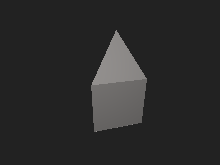|
Elongated triangular pyramid
 In geometry, the elongated triangular pyramid is one of the Johnson solids (J7). As the name suggests, it can be constructed by elongating a tetrahedron by attaching a triangular prism to its base. Like any elongated pyramid, the resulting solid is topologically (but not geometrically) self-dual. ConstructionThe elongated triangular pyramid is constructed from a triangular prism by attaching regular tetrahedron onto one of its bases, a process known as elongation.[1] The tetrahedron covers an equilateral triangle, replacing it with three other equilateral triangles, so that the resulting polyhedron has four equilateral triangles and three squares as its faces.[2] A convex polyhedron in which all of the faces are regular polygons is called the Johnson solid, and the elongated triangular pyramid is among them, enumerated as the seventh Johnson solid .[3] PropertiesAn elongated triangular pyramid with edge length has a height, by adding the height of a regular tetrahedron and a triangular prism:[4] Its surface area can be calculated by adding the area of all eight equilateral triangles and three squares:[2] and its volume can be calculated by slicing it into a regular tetrahedron and a prism, adding their volume up:[2]: It has the three-dimensional symmetry group, the cyclic group of order 6. Its dihedral angle can be calculated by adding the angle of the tetrahedron and the triangular prism:[5]
References
External linksInformation related to Elongated triangular pyramid |
||||||||||||||||||||||||||












